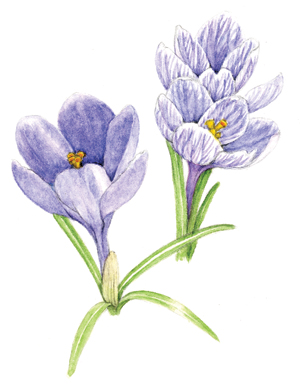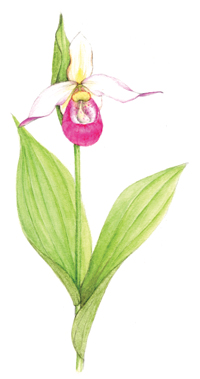Arise, my love, my fair one, and come away, for, lo, the winter is past, the snow is over and gone, the flowers appear on the earth, and the sound of the mourning dove is heard in the land.
—From the Song of Solomon [Revised Maine Version]
Dear Friends:
As the sun accomplishes its conquest of winter, the buds on red maples are swelling and showing their dark crimson colors, while pussy willows and poplar catkins are waiting for some warm weather to carry their golden pollen from tree to tree. Yellow coltsfoot and crocuses, the first showy flowers of spring, are coming into bloom in sheltered places and we’ll be seeing bluets in the mountain meadows any day now.

Illustration by Candice Hutchinson
Mountain report, early April
In the old growth woods around the summit of Awanadjo—Blue Hill or “small misty mountain” in the Algonquian language—there is still plenty of snow and ice. It is old snow, littered with bits of lichen and bark, tufts of spruce and fir needles, twigs, leaves, moss, cone scales, animal droppings, and the occasional bit of fur or feather left by the battering of many storms through a long hard winter. As the old snow melts, these leavings of death slowly make their way back down to whence they came, to replenish the ground of life for coming generations, so that the cycle can be repeated. All across the face of the mountain, nothing needs to remain dead for long. Nothing needs to remain useless or idle because the great enterprise of life puts everything quickly back to work.
A subtle change in celestial light or earthly color alters the mountain’s expression from one season to the next.
In coming days all the detritus of the past season will become food for the soil, the largest living being on Earth, from whose body we all come, upon which we all feed, and to which we all return. It’s a sparse soil up there, thin and sour and young, laid up over only 10,000 years since the last glaciers retreated, but it is rich enough to feed the boreal forest and all of its creatures year after year and to provide us with food and fuel through the long winters. And now it awakens to continue its labors of love.
Saltwater report, early April
Tiny glass eels or “elvers” (Anguilla rostrata) are running into the mouths of rivers and streams. These are tiny transparent creatures smaller than a minnow with huge dark eyes and a barely visible spine ending in a brain that is little larger than the head of a pin. Yet it somehow contains a vast catalog of genetic memory that allows these fragile fishes to navigate all the way from the North Atlantic, where they were born, to freshwater estuaries and upstream to the lakes or ponds whence their ancestors came, but where these infants have never been. How do they find their way, and what drives them? A global positioning system that was old when the dinosaurs walked.
After a decade or more, the eels run downstream to the sea again and swim against the Gulf Stream to return to the Sargasso Sea in the North Atlantic gyre. As they leave freshwater they stop eating and their guts gradually dissolve as they journey to the place they were spawned, surviving on nothing but their own bodies. An eel is miracle enough.
Field and forest report, mid April
Goldfinches are decked out in their new yellow spring suits for courting, as juncos and song sparrows call from the woods. Tractors bounce along the roads as plowing begins where the ground is dry enough. Crocuses and Scylla are in bloom in the dooryard, and daffodils and lilies show their green spikes above the dark earth.

Illustration by Candice Hutchinson
Mountain report, mid April
Recent rains kept the summit of Awanadjo obscured by mist while water rushed down the slopes. Vernal pools in the woods are still filled with ice, though spring peepers are reported calling in warmer pools and ponds. Mosses and lichens luxuriate in sun and rain on the rocky slopes; this is their moment in the sun. They get its undivided attention until they are shaded again when fresh, new leaves come back to the trees.
Natural and Un-natural Events, late April
We’ve had a stretch of dry weather after a stretch of wet weather, but we’re still not satisfied, and now all the talk at the store and the post office is about how we need some rain. This is called ‘human nature.’ Meanwhile, on the blueberry barrens in Washington County, the age-old practice of agricultural burning is still carried out in April. In former days, straw was scattered all over the field and when the wind was right this was set afire. Burning a field every other year increases yield by killing insect pests and incinerating the competition. Nowadays an oil-burning, fire-breathing monster is dragged behind a tractor that blackens row after row of blueberries. Men on ATVs follow with water tanks and hoses, putting out the fires as soon as they show any sign of creeping off into the neighboring woods or fields. So, yes, we could use some rain, but only at night, and not on the weekends, and no more than about one quarter inch at a time, please.
Field and forest report, early May
Bluets and violets are in bloom in the fields and beach plum, shadbush and white ash are in bloom in the margins. The white ash (Fraxinus Americana) has large round clusters of dark red to burgundy flowers on its bare, upswept branches. Lupine leaves are full-sized but the flower stalks have yet to emerge. Spring songbirds are returning and the sound of the white-throated sparrow is heard in the land. Turkey vultures soar with a pronounced up-tilt to their wings.
Natural events, early May
As the elver season winds down, the alewives will be coming upstream. Why they are called ‘alewives’ is beyond me. It conjures up a picture of a burly washerwoman with a brimming, foaming tankard in one hand and a rolling pin in the other, and no fins or scales. But, no, the alewife (Alosa pseudoharengus) a salt/freshwater fish that comes up rivers and streams in spring and is caught with dip nets to be smoked for human consumption or used as lobster bait. The alewife fishery, like most others, has declined dramatically in recent times but efforts at conservation are having some productive effect.
Field and forest report, late May
A walk in the woods reveals to the wondering eye clusters of rare and delicate trillium in bloom. Nearby, spears of blue flag rise from the mud, and Rhodora, New England’s wild azalea, is covered in shocking pink bloom. Ox-eye daisies are raising their gold and white early blooms above scalloped deep green leaves while magenta lady-slippers and blue and white forget-me-nots show their shy flowers in shady places. Apples, pears, and lilacs are in bloom while wild cherries and shadbush petals are falling.

Illustration by Candice Hutchinson
Rank opinion
There is a comforting rhythm to the changing of the seasons. As alike as each year is to the one before it and the one after, there is always a faint shade of difference. Though the moose and men and pine trees that we see today look much like those seen in these parts since the end of the last Ice Age, they are not the same. They are minutely different. They have changed, evolved, and adapted to each other and their surroundings as has every other creature. One changes and the others change in response. This is the endless dance of life; and we are not the composer or the conductor of this dance, we are only dancers in it.
Seedpods to carry around with you
From the Book of Ecclesiastes: “The wind blows to the south, and goes round to the north; round and round goes the wind, and on its circuits the wind returns. All streams run to the sea, but the sea is not full; to the place where the streams flow, there they flow again.”
From William Shakespeare: “And this, our life, exempt from public haunt, finds tongues in trees, books in the running brooks, sermons in stones, and good in everything.”
From Helen Keller: “Everything has its wonders, even darkness and silence, and I learn, whatever state I may be in, therein to be content.”
That’s the almanack for this time. But don’t take it from us—we’re no experts. Go out and see for yourself.


Rob McCall is a journalist, naturalist, and fiddler, and pastor of the First Congregational Church of Blue Hill, Maine UCC. This column derives from his weekly radio show on WERU, 89.9 FM, Blue Hill and 99.9 Bangor. The author’s latest book, Great Speckled Bird: Confessions of a Village Preacher (Pushcart Press), is available through your local bookstore. Readers can contact him directly via e-mail: awanadjoalmanack@gmail.com or post a comment using the form below.

Illustration by Candice Hutchinson

Illustration by Candice Hutchinson

Illustration by Candice Hutchinson
Yr. mst. hmble & obd’nt servant,
Rob McCall


Rob McCall is a journalist, naturalist, and fiddler, and pastor of the First Congregational Church of Blue Hill, Maine UCC. This column derives from his weekly radio show on WERU, 89.9 FM, Blue Hill and 99.9 Bangor. The author’s latest book, Great Speckled Bird: Confessions of a Village Preacher (Pushcart Press), is available through your local bookstore. Readers can contact him directly via e-mail: awanadjoalmanack@gmail.com or post a comment using the form below.
Magazine Issue #
Display Title
Awanadjo Almanack
Secondary Title Text
Welcome to Blue Hill: the Town, the Bay, the Mountain
Sections






